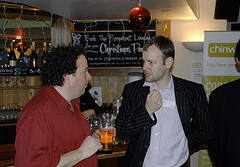What will Enterprise 2.0 look like? Some Thoughts from Crystal Balls
 The technology used in businesses is changing rapidly. The technologies we use in the office today would have been the stuff of science fiction just a few decades ago. New technologies are arriving faster than most businesses can adapt and adopt. Within this change is the potential for both increasing, and decreasing, productivity. What is around the corner?
The technology used in businesses is changing rapidly. The technologies we use in the office today would have been the stuff of science fiction just a few decades ago. New technologies are arriving faster than most businesses can adapt and adopt. Within this change is the potential for both increasing, and decreasing, productivity. What is around the corner?
I’m am convinced that the business technology of the future is the consumer technology of today. In past decades technology flowed from business use to consumer use. Think of things like mobile phones and email, which started off as business tools, then became affordable and accessible at home. That flow is now reversing. The productivity tools of the future are in use by the youth of today, and they will bring them into businesses as they join the workforce. It will be the consumerization of IT.
Back in December, I was at Chinwag Live, Xmas Futures, Crystal Balls, an event that gathers some of the most intelligent figures from the world of digital marketing to have a shot at predicting where the industry will be in 5 years time. Now, if property prices are anything to go by, the newspapers are having trouble agreeing on what happened last month, so predicting technology five years out is a long shot! But this is an arena that is on the cutting edge of change and gets to see just that little bit further ahead.
The event confirmed many of my current thoughts, as well as being a great chance to have some meaningful debate. Here I am with the legendary Sam Michel, CEO of Chinwag, at the end of the session as we mulled over the discussions (there is a podcast here).
Social media is becoming more and more prominent. Jon Bains – Co-Founder of Lateral – raised the issue of Facebook versus LinkedIn. For me, the two are complimentary. I use Facebook for personal friends and LinkedIn for work associates, and some people I connect to on both – you’ll find a link to my LinkedIn profile in the about page. They represent two very different faces, excuse pun, of social networking applications. The teen-laden, wild partying Facebook, and the straight-laced executive LinkedIn. Now I hear of more and more people using even Facebook for business networking.
Today’s business leaders and tomorrow’s will be very different. The fact is that social networking tools, in one form or another, are here to stay. I predict they will be standard tools for many large businesses in years to come, although run on private, secure intranets.
Today most IT managers and business leaders are missing out on the potential productivity benefits of these tools. They provide an amazing ability to create and strengthen social bonds in businesses and enable people to find the resources they need to get their job done. In years gone by, the resources we needed to get the job done were ‘things’. Where is the plough? Where is the hammer?
Today, in a knowledge-led business world, they are the people with knowledge and skills. Where is someone who understands this? Where is the person who can interpret this data? Where is someone who has done this before? In a large company, with many staff telecommuting, you can’t get those answers by shouting across the desk anymore. Something else is needed.
Microsoft sponsored some recent research on skills businesses need, which is covered in an interesting BBC article here. The modern work place demands both people skills and IT skills. These two skill sets are becoming intertwined, as computers become the medium through which we communicate. Social Networking tools are powerful at expanding our social network, both in business and at home. Used badly, they can be a massive drain in terms of time and stress (see “web 2.0 as the new master” by Maz Hardy). Used wisely, they just might be one of the productivity tools of the future.


[…] Benjamin takes a look at how a broader slice of the young people of today will have much more advanced IT skills than ever before. IT used to be the domain of those with very specialized training, nowadays it seems that every kid on the block is learning HTML and PHP and coding their own websites, writing apps for Facebook, generally doing the things that “nerds” did a generation ago. …the issue of Facebook versus LinkedIn. For me, the two are complimentary. I use Facebook for personal friends and LinkedIn for work associates, and some people I connect to on both – you’ll find a link to my LinkedIn profile in the about page. They represent two very different faces, excuse pun, of social networking applications. The teen-laden, wild partying Facebook, and the straight-laced executive LinkedIn. […]